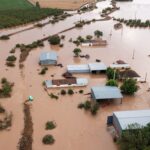Natural catastrophes in 2023 caused global economic losses of $250 billion, with insurers and reinsurers paying $95 billion of that amount, according to Munich Re.
Last year’s insured losses of $95 billion are close to the five-year average of $105 billion, above the 10-year average of $90 billion but lower than the 2022 price tag of $125 billion, said Munich Re in its report on the nat cats of 2023.
The report noted that industrialized countries avoided the mega-disasters that often drive up losses, such as Hurricane Ian in 2022, which caused overall losses of $100 billion and insured losses of $60 billion. Instead, the loss statistics in 2023 were driven up by the large number of severe regional thunderstorms in the U.S. and in Europe (also known as severe convective storms), which caused overall economic losses of $76 billion and insured losses of $58 billion.
Breaking the price tag down into regions, Munich Re said assets worth around $66 billion were destroyed in North America, of which $50 billion was insured, while in Europe the economic price tag for these extreme storms was $10 billion, of which $8 billion was insured, Munich Re said.
Loss statistics from thunderstorms in North America and other regions are trending upward, Munich Re said, noting that scientific research indicates that climate change is driving severe weather with heavy hailstorms.
North America (which includes Central America and the Caribbean) again recorded the highest losses worldwide, although this year its share of global losses was smaller than usual at 40 percent, compared with the five-year average of 57 percent, said Munich Re. Natural disasters in North America destroyed assets worth $100 billion, of which around $67 billion was insured. In spite of the large number of severe thunderstorms, the loss amount for all natural disasters was less than that of the previous year (2022) when overall losses came to $160 billion, with insurance paying for $100 billion of the total cost.
Costliest Events
The year’s most destructive natural disaster – in terms of overall cost and human life – was the earthquake series in southeast Turkey and Syria in February. With a 7.8 magnitude, it was the strongest quake to hit Turkey in decades. Some 58,000 people were killed, many buildings collapsed, and there was significant damage to infrastructure, said Munich Re.
With overall losses of around $50 billion, it was also the year’s costliest natural disaster, but insured losses came to just $5.5 billion, despite the fact that earthquake insurance is mandatory for residential buildings in Turkey under the Turkish Catastrophie Insurance Pool (TCIP).
The second-costliest natural disaster in terms of overall economic losses was Typhoon Doksuri, which brushed the coastline of the Philippines before making landfall at Jinjiang in Fujian province on the Chinese mainland in July. With wind speeds of around 180 kilometers per hour (nearly 112 miles per hour), Doksuri was accompanied by extremely heavy rainfall that triggered destructive flooding. Overall losses came to around $25 billion, of which only roughly $2 billion was insured – an example of the large insurance gap for natural disasters that persists in China, Munich Re said.
As the third-costliest event in terms of overall losses, Hurricane Otis was described by Munich Re as another “exceptional event” because it intensified so rapidly. Within 24 four hours, it developed from a weak tropical storm to the highest-category hurricane, making landfall in Acapulco with wind speeds of up to 265 km per hour (165 mph) – the most severe storm on record to hit Mexico’s Pacific coast. Overall losses are estimated at $12 billion, with insured losses at around $4 billion due to the high concentration of hotels in the city.
“Doksuri and Otis fall into the pattern that scientists expect as a result of climate change, namely a shift toward an increased number of intense storms and storms with extreme rainfall. Experts also attribute the more frequently observed rapid intensification of tropical storms to climate change,” said Munich Re.
“The warming of the earth that has been accelerating for some years is intensifying the extreme weather in many regions, leading to increasing loss potentials. More water evaporates at higher temperatures, and additional moisture in the atmosphere provides further energy for severe storms. Society and industry need to adapt to the changing risks – otherwise loss burdens will inevitably increase,” according to Ernst Rauch, chief climate scientist, in a statement.
Other findings from the Munich Re report include:
- Overall economic losses from natural disasters were dominated by severe storms: 76 percent of these losses were weather-related, while 24 percent had geophysical causes.
- Temperature records were broken in 2023 in the hottest year since measurements began, topping off a decade of the hottest years on record.
- Two thunderstorm outbreaks in the U.S. in March (Midwest) and in June (Texas) were among the year’s costliest natural disasters worldwide in terms of insured losses. These thunderstorm series alone caused combined overall losses of $17 billion, with insurance according for around $12 billion of the total.
- Large parts of the coastal town of Lahaina on the island of Maui in Hawaii were destroyed in August by a devastating wildfire, which brought overall losses of an estimated $5.5 billion, of which roughly $3.5 billion was insured.
- Losses from natural disasters in Europe came to $83 billion (largely due to the earthquake in Turkey) with insured losses amounting to around $19 billion. In addition, storms in the Alpine region and in the Mediterranean area contributed to record thunderstorm losses. In July and August, hailstones measuring up to 19 centimeters (7.48 inches) in diameter caused billions of dollars of losses in northern Italy and several other regions.
- In the Asia-Pacific and Africa region, the overall losses in 2023 of $64 billion were slightly lower than in the previous year of $66 billion. Approximately $8 billion of the overall amount was insured, compared with 2022 when the insured price tag was $11 billion.
- Japan, a country highly exposed to natural hazards, was largely spared major damage in 2023.
- While Typhoon Doksuri was the year’s costliest disaster in terms of overall losses, two major catastrophes in New Zealand together accounted for the highest insured losses in Asia-Pacific (around $4 billion). Massive floods in and around Auckland, New Zealand, in early February, caused insured losses of nearly $2 billion and overall losses of $2.9 billion. In mid-February, Cyclone Gabrielle hit New Zealand’s North Island and Norfolk Island, resulting in huge damage and bringing losses at similar levels to those from the floods.
- In September, around 3,000 people were killed in a 6.8 magnitude earthquake in Morocco, the strongest quake to hit Morocco in more than 100 years. Overall losses came to approximately $7 billion with only $300 million taken up by insurance.
- The number of deaths caused by natural disasters rose to 74,000 in 2023, well above the annual average of the last five years of 10,000 per year. Around 63,000 people across the globe (85 percent of the year’s total fatalities) lost their lives as a result of earthquakes – more than at any time since 2010.
Photograph: Search and rescue teams look for survivors in a former Dollar General after a tornado on June 22, 2023, in Matador, Texas, a line of severe storms produced what a meteorologist calls a rare combination of multiple tornadoes, hurricane-force winds and softball-sized hail in west Texas. (Annie Rice/Lubbock Avalanche-Journal via AP)





















 Executives on the Move at Liberty Mutual, Cowbell, W. R. Berkley
Executives on the Move at Liberty Mutual, Cowbell, W. R. Berkley  Is the AI Boom a Bubble Waiting to Pop? Here’s What History Says
Is the AI Boom a Bubble Waiting to Pop? Here’s What History Says  Five AI Trends Reshaping Insurance in 2026
Five AI Trends Reshaping Insurance in 2026  Surge of Supercharged Hurricanes Prompt Call for Cat 6 Classification
Surge of Supercharged Hurricanes Prompt Call for Cat 6 Classification 





